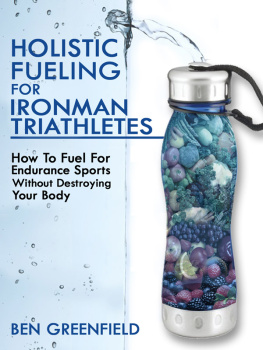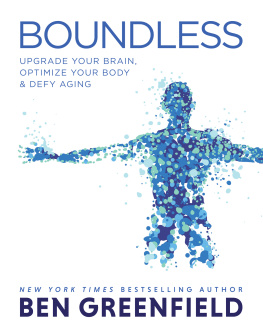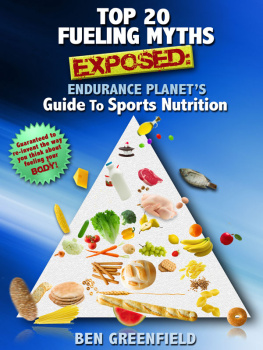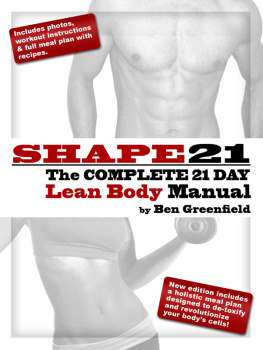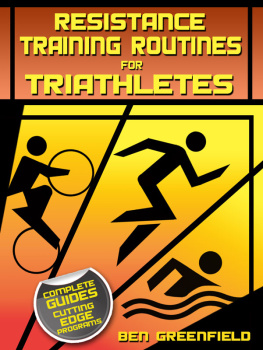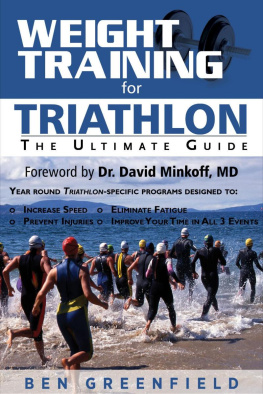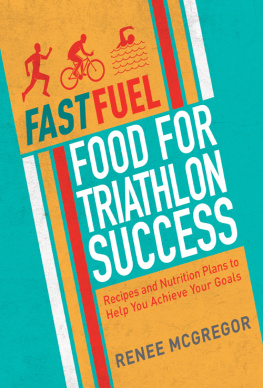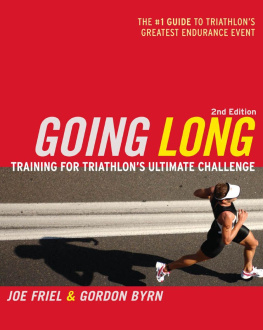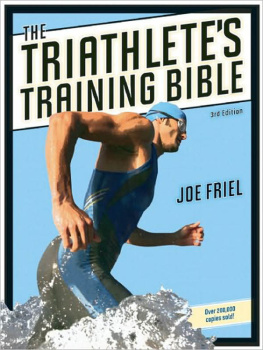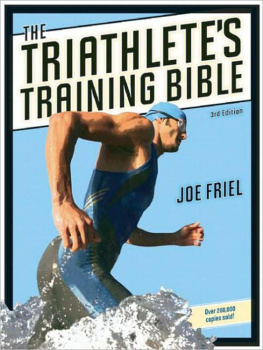Prior to beginning any exercise program, you must consult with your physician. You must also consult your physician before increasing the intensity of your training. The information in this book is intended for healthy individuals. Any application of the recommended material in this book is at the sole risk of the reader, and at the readers discretion. Responsibility of any injuries or other adverse effects resulting from the application of any of the information provided within this book is expressly disclaimed.
Price World Publishing
www.PriceWorldPublishing.com
Copyright 2012 by Ben Greenfield
All rights reserved. Neither this book, nor any parts within it may be sold or reproduced in any form without permission.
eISBN: 9781619841369
Introduction
Designed by exercise physiologist, sports nutritionist, andtriathlon coach Ben Green field, this comprehensive dailynutrition plan for Ironman goes far beyond simple meal suggestions.
Instead, youll receive an exact weekly plan for base training, building to a race, carb loading, race day fueling, and even off-season and recovery weeks.
With the life of a busy Ironman triathlete in mind, the mealplan includes minimal meal preparation times and foodchoices that are easily accessible at commercial grocerystores.
In addition, nutritional supplements and ergogenic aids foreach period of the training year are included, completewith discount codes and dosage suggestions.
Most importantly, this plan is designed with your health inmind. You now have the ultimate solution to consumingthousands of calories without destroying your body.
Below, you will find a personal message from the author. Youll then learn the practical and easy-to-understand human science behind the nutrition plan. A detailed, no guess work meal plan follows,along with a final FAQ and dietary supplements section.
Enjoy!

A word from author Ben Greenfield:
You, as an endurance athlete, need to eat massive quantities of food, which is why I wrote this book (OK, I also wrote it for you coaches who really want to help your athletes optimize their daily nutrition habits for peak performance).
As a matter of fact, compared to an average person, during your training for ultra-endurance events such as Ironman triathlon, you will burn through an extra 1500-3000 calories per day. And with this extreme amount of energy utilization, most triathletes dont feel the need to bother with dieting or weight maintenance. Heck, some of usthis sport so we can eat as much as we want!
Unfortunately many endurance athletes use the rigor of training and a speedy metabolism to justify a diet that is incredibly calorie dense (as it should be), but is also high in foods that can cause damage to human performance, the immune system, the heart, the hormones and overall health. Even though you may think that as long as your furnace is burning hot enough you can fuel it with whatever youd like, this is simply not the case. The combustible byproducts actually matter!
For example, common traditional foods for fueling endurance sports include high carbohydrate sources such as orange juice, bagels, cereal, crackers, bread, pasta, scones and fruit smoothies. With the advent of commercialized sports nutrition, the dietary staples of an Ironman triathlete now include sports bars and cookies, gels, powders, gummy chews and specially formulated energy drinks.
But a diet high in these type of refined carbohydrates and fabricated foods can cause excessive levels of glucose in the bloodstream, a condition known as hyperglycemia. During exercise, the excess glucose is used for energy. But most triathletes continue to consume these type of high-carbohydrate foods, even outside training.
Several studies have demonstrated a link between hyperglycemia and production of free radicals by immune cells. These free radicals can not only cause inflammation, but also increase potential for insulin resistance, damage the immune system, and reduce exercise recovery. In addition, as you will find in this book, an enormous number of chronic diseaseshave been linked with hyperglycemia.
When this diet-based inflammation is combined with muscle tissue inflammation from repetitive motion training such as hundred mile bike rides and twenty mile runs, the body is constantly barraged with damaging free radicals. As a result of chronic inflammation, an athlete may experience constant fatigue, sore joints, disrupted sleep patterns, and frequent sickness. New studies on plaque formation in the coronary arteries has even suggested that refined sugars may play a larger role than saturated fat in dangerous LDL cholesterol production.
In this book, youll learn all about the nitty-gritty details of hyperglycemia, as well as exactly what type of foods you can eat to both control inflammation and reduce your risk for sending your blood sugar levels on a roller-coaster ride. Youll also learn important timing techniques to enhance your sensitivity to insulin, a very important hormone involved with sugar utilization.
But your concern as an Ironman triathlete does not stop with refined sugar consumption. For example, an extremely high daily calorie intake also increases the likelihood of consuming large amounts of common food allergens such as dairy, wheat, whey, soy and eggs. As a result, many triathletes experience bloating, gas, constipation, skin problems and increased susceptibility to colds and flu.
These immune system difficulties are often chalked up to "hard training". However, even when the high volume of training finally does subside, many of these problems can continue to cause a triathlete to experience poor health and gain significant amounts of fat (leading to the ever-growing population of overweight or sick ex-Ironman athletes).
So while an Ironman triathlete may appear to be slim and fit, there are often complex, diet-related health issues that go far beyond physical appearance. Perhaps youve experienced this phenomenon.
You look at your body in the mirror. Perhaps your body looks fit and trim on the outside (although most endurance athletes have that small pouch on inflammatory-based fat on the hips or abdominals). But inside, youve experienced extreme fatigue in the afternoons, mind fuzziness, aches and pains that are constantly barraging one joint or another, mood swings, stale legs during a workout, frequent hitting the wall during races, and constant colds, flus, and immune system breakdowns.
It is very important to understand that with an exercise regimen that is already very difficult for the average human body to absorb, you as a triathlete must adopt a nutrition protocol that supports complete health, and not just gasoline fuel for exercise. The solution that is presented in this book involves a diet that focuses on fighting inflammation and controlling refined sugar consumption, insulin levels and potential food allergens.
How is this accomplished? For example, large amounts of wheat and cereal-based carbohydrates are decreased in favor of non-gluten sugars such as sweet potatoes and yams, healthy whole grains like quinoa, amaranth, and millet, and inflammation-fighting, fiber-based carbohydrate sources like chickpeas and lentils. Healthy fats such as nuts, seeds, avocadoes, fish, and olive oil are also included to provide dense, long-lasting energy sources.
Lean protein needs are often satisfied by the foods listed above, but in this book, protein sources also
Next page
